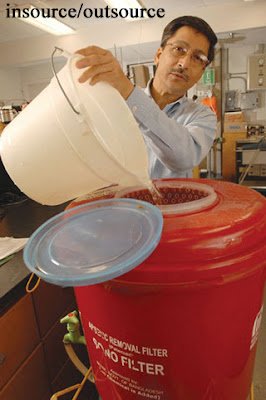More than 1.1 billion people lack access to safe water and 2.6 billion people lack even basic sanitary facilities. Diseases caused by unsafe drinking water and inadequate sanitation remain humanity’s most serious public health threat, causing 80% of the sicknesses in developing countries and annually killing between 2 and 5 million people, mainly young children. Lack of water and sanitation undermines the sustainability of other critical needs, including education, economic development, nutrition, environmental health and gender equality.[1]
Even in the US where our drinking water is relatively safe, it's interesting to see the allowable amount of contaminants (see: toxins) as prescribed by the EPA.
7 million fibers of asbestos per liter?
Cyanide?
Ethylbenzene?
Sometimes (this being one of those times) you find a site you wish you never would have found.
Anyways...
When I lived in the South Pacific the access to potable drinking water was readily available, but treatment was still highly recommended. SO I had some military-grade chlorotabs I could have added, but the people of Kiribati love their tea (as did I). Imagine making coffee in a machine lined with residual dishsoap and you can envision how it would turn out. Well, the tabs were basically like adding a teaspoon of bleach to soapy coffee. Yummy.
So I relied on the ol' boil method of sterilization. I'd boil a large batch of water on my kerosene stove for about 10 minutes, dump it into my 15 gallon gas can (a brand new gas canister I scientifically converted for water useage...err...by adding water), and repeated until the can was full. I'd do this about once a week - all the while ignorant to the fact that boiling does not eliminate pathogens in long-term storage.
Giardiasis is not fun. Repeat. Not fun.
As design concepts like the Playpump begin to make their round on the internet (again), the notion of clean water/clean water access is back in my mind. Even as a diligent boiler, I was sick quite a bit, so I'm interested to see what new products are on the market.
For the Military/Rescue Worker/Humanitarian Aid Worker:
The Lifesaver System
A chemical-free ultra-filtration system developed specifically for industrial applications. It's basically a Nalgene with a brain.
 The LIFESAVER bottle also comes with an activated carbon filter...which reduces a broad spectrum of chemical residues including pesticides, endocrine disrupting compounds, medical residues and heavy metals such as lead and copper. It also eliminates bad tastes and odours from contaminates such as chlorine and sulphur.
The LIFESAVER bottle also comes with an activated carbon filter...which reduces a broad spectrum of chemical residues including pesticides, endocrine disrupting compounds, medical residues and heavy metals such as lead and copper. It also eliminates bad tastes and odours from contaminates such as chlorine and sulphur. Users of iodine and other foul-tasting chemical sanitizers will appreciate that LIFESAVER bottle does NOT use any chemicals. It simply filters out all water-borne pathogens creating safe sterile drinking water - fast.
Users of iodine and other foul-tasting chemical sanitizers will appreciate that LIFESAVER bottle does NOT use any chemicals. It simply filters out all water-borne pathogens creating safe sterile drinking water - fast.They've even gone so far as to create an iconographic instructions so that anyone can learn how to use the pump and change the cartridges, regardless of their native tongue.
For the back yard:
The Tidal Flow Wetland Living Machine
This system incorporates a series of tidal flow cells, which are alternately flooded and drained with cycle periods of a day or less to achieve up to tertiary treatment. These systems are designed to be both cost and energy efficient and incorporate the latest in Living Machine technology.

The Tidal Flow Wetland Living Machine System consists of four to six Tidal Wetland cells connected in series by integral pump stations and a control system. Each Tidal Wetland cell is comprised of a watertight basin with a bottom drain system covered by engineered media fill and vegetation on top. Pumps in each basin flood and drain each wetland cell several times daily. The flood and drain process provides all the oxygen necessary for treatment without mechanical aeration.
For the far-flung camper in distress:
The Personal Water Purifier
Pop this compact purifier's inlet pipe into a handy water source and start pumping the pump. Water will start to flow out of a side pipe and after 2 minutes, the water will be disinfected, filtered and free from any nasties.

For the easy distribution in remote regions:
The Life Straw
Time magazine's Best Invention of 2005 is still around, which means that it might not be a design gimmick after all. You've got to admit: no electricity, small shipping size, easy to use, cheap ($2.00!), no spare parts, and effective? Sounds too good to be true...but it's still receiving recognition.
 LifeStraw® personal is a portable water purifier that effectively removes all bacteria and viruses responsible for causing common diarrhoeal diseases. LifeStraw® personal requires no electrical power or spare parts and can be carried around for easy access to safe and clean water.
LifeStraw® personal is a portable water purifier that effectively removes all bacteria and viruses responsible for causing common diarrhoeal diseases. LifeStraw® personal requires no electrical power or spare parts and can be carried around for easy access to safe and clean water.LifeStraw® personal contains a specially developed halogenated resin that kills bacteria and viruses on contact; a special chamber further increases the exposure of micro-organisms to the halogenated resin, thereby enhancing the killing effect. Micro-filters are used to remove all particles down to 15 microns. Activated carbon adsorbs residual iodine thereby improving the taste of water.
 For those with little resources:
For those with little resources:The BioSand Filter
Rapid sand filtration is mainly used in combination with other water purification methods. The main distinction from slow sand filtration is the fact that biological filtration is not part of the purification process in rapid filtration. Rapid filtration is used widely to remove impurities and remnants of flocculants in most municipal water treatment plants. As a single process, it is not as effective as slow sand filtration in production of drinking water. In general, slow sand filters have filtration rates of up to 0.4 m/hour, as opposed to rapid sand filters which can see filtration rates of up to 21 m/hour.

As its name suggests water in rapid filters passes quickly through the filter beds. Often, it has been chemically pre-treated, so that little biological activity is present. Physical straining is the most important mechanism present in rapid filters. Particles that are larger than the pore spaces between the sand grains are trapped - smaller solids however can pass through the filter. Rapid sand filtration removes particles over a substantial depth within the sand bed.
For those on the go:
The drinkSAFE System
drinkSAFE offers the best off all worlds providing canteens, inline hydration, water straws, and gravity buckets.
 All systems are proven to deliver up to 200+ Gallons- 800+Litres water - equivalent to 6 glasses of safe drinking water a day for a year.
All systems are proven to deliver up to 200+ Gallons- 800+Litres water - equivalent to 6 glasses of safe drinking water a day for a year.All will take out waterborne disease causatives and chemicals including purification chemical taste ,herbicides , pesticides,Voc's, PCB's , Metals and other contaminants in water supplies. We are now incorporating our UK developed and Uk government tested MoD spec purification filter systems in bottles, canteens, Inlines and forces waterbags . These are the most proven tested contaminant micro purification filters in the world.
For the low-tech sun goddess:
The Sun
A Village in Tanzania is trying something so new, it's as old as new can be.
 A village is piloting a new way to purify water with simple means. The method is so simple it hurts to think that it has not been put into wide use. Take a transparent plastic water bottle, fill it up with water, lay it on a black roof for several hours. If the sun is beating down good, one hour is enough.
A village is piloting a new way to purify water with simple means. The method is so simple it hurts to think that it has not been put into wide use. Take a transparent plastic water bottle, fill it up with water, lay it on a black roof for several hours. If the sun is beating down good, one hour is enough.The combination of the sun's ultra violet rays and heat kills any pathogenic germs - the ones that spread much illness in Africa.
For the arsenic-poisoned water of India:
The SONO Filter
The brainchild of Bangladesh native Professor Abul Hussam, this filter was awarded the $1 Million Grainger Challenge Award. More than 18 million people in Bangladesh are struggling with arsenic-contaminated water, including Hassam's family, a fact he surprisingly discovered at the start of his research. `

Simple, inexpensive and made with easily available materials, the filter involves a top bucket, which is filled with locally available coarse river sand and a composite iron matrix (CIM). The sand filters coarse particles and imparts mechanical stability, while the CIM removes inorganic arsenic. The water then flows into a second bucket where it again filters through coarse river sand, then wood charcoal to remove organics, and finally through fine river sand and wet brick chips to remove fine particles and stabilize water flow.

